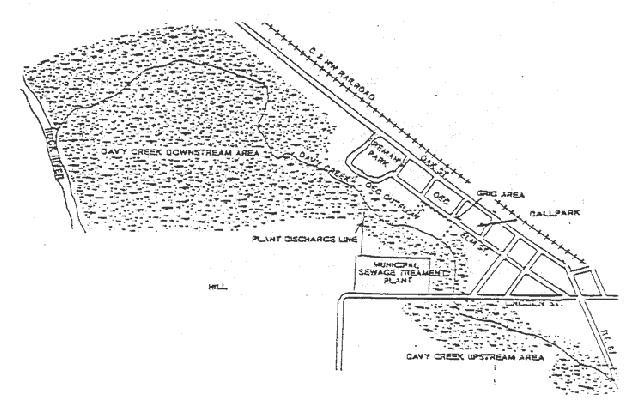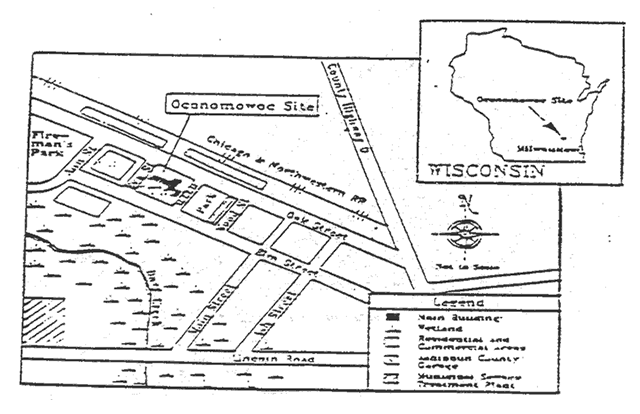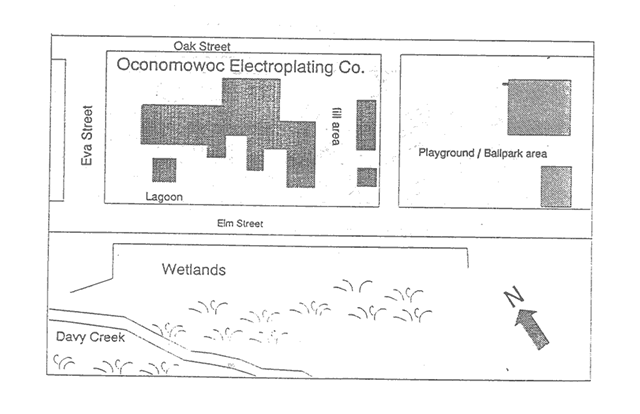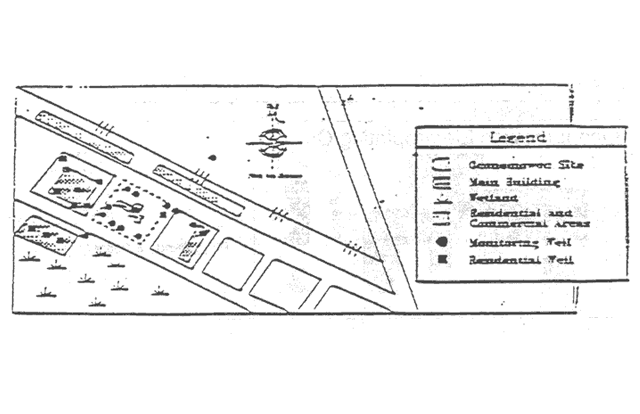PUBLIC HEALTH ASSESSMENT
ASHIPPUN, DODGE COUNTY, WISCONSIN
- The OEC Superfund site poses a public health hazard primarily from ingestion of possible future increased levels of site contamination in residential groundwater. Site chemicals are present in residential groundwater at low levels that are not expected to cause adverse health effects. The migration of higher levels of VOC-contaminated groundwater into residential wells west and northwest of the OEC site may occur in the future. Five of the VOCs detected in groundwater monitoring wells exceed the WGES. Several of these are carcinogens. Two of the VOCs, l,2-dichloroethylene and trichloroethylene were detected in the off-site monitoring well located approximately sixty feet east of a residential well. These chemicals are also identified as on-site groundwater contaminants. There would be low increase in the cancer risk for persons consuming the VOC contaminated water.
- The inorganic compounds cadmium and cyanide have been identified as on-site contaminants. Until 1992, these contaminants had not been detected in residential wells. However, sampling completed in April 1992 detected cyanide in residential wells at levels below (20 µg/L was the highest) the WGES of 200 µg/L. Cyanide at this level is not known to cause adverse health effects. The residential wells with cyanide are located west of the OEC site. Groundwater flows west-southwest from the site and may carry much higher levels of cyanide representative of on-site contamination levels, 510 µg/L.
- On-site soil contains high levels of cadmium and trichloroethylene. The highest levels are reported to be southeast of the main building in the lowland area. Persons trespassing on the site or workers remediating the site would be at risk of dermal, inhalation and ingestion exposure. Trespassers are currently restricted from the site by a fenced and locked perimeter.
- Lagoon sludge contains high levels of cadmium, chromium and lead. The lagoon liquid contains high levels of methylene chloride. These environmental media could pose an inhalation and dermal exposure risk to persons trespassing on the site or workers remediating the site.
- Residential wells located west of the OEC had high levels of the metals lead and zinc. Zinc is not viewed as a contaminant of concern at the levels identified. However, lead (20.5 µg/L) exceeds the EPA’s Action Level of 15 µg/L. It is possible that the lead may not be from the OEC site but may be leaching from pipes or solder in the home. It presents an exposure concern for infants and young children.
- The Davy Creek Wetland contains an estimated 6,000 cubic yards of contaminated sediment. Arsenic, cadmium, chromium, copper, lead, nickel, and cyanide are the contaminants of concern. Outdoor enthusiasts, children, and workers entering this area would be at slight risk of dermal and ingestion exposure since the sediments are generally covered by several inches to several feet of plant root material. During periods of drought, inhalation of contaminated dust would also be an exposure concern. In particular, exposure to chromium, lead and nickel would present an increased health risk to individuals. Chromium and nickel would most likely cause allergic type responses (skin redness, swelling) in sensitive individuals. Lead exposure to young children could increase the risk of developmental disorders such as decreased intelligence quotient (IQ) and reduced growth. Citizens expressed concern about the risks associated with exposure to chemicals in the wetlands.
- Continue to regularly sample residential wells to provide early warning of the possible migration of hazardous levels of site contaminants and reduce the possibility of ingestion exposures. Further, as soon as possible, steps should be taken to prevent the further migration of contaminants from the OEC site.
- Continue to monitor for contaminants in the on and off-site monitoring wells.
- Continue monitoring residential wells in the path of the contaminated groundwater plume. In particular, homes to the west and southwest of the site. Several of these homes are adjacent to monitoring wells with contaminated groundwater. Water should be checked for VOCs, metals, and cyanide.
- Include the well located in the Ashippun town garage in the ongoing groundwater monitoring program. The chemical 1,2-dichloroethane had been detected during water testing completed in 1986.
- Continue to insure that access to the site is restricted. Some areas of the site have soils contaminated with high levels of trichloroethylene and cadmium.
- Implement, during the remediation of on-site soils, appropriate dust control measures to prevent wind dispersion of contaminated soil to nearby residences.
- Further evaluate residential wells identified as having levels of lead 15 µg/L to determine the source.
- Ensure that the contaminated wetland area is properly posted and secured. Residents should be informed of the potential exposure risk posed by the contaminated wetland sediments. In particular, when this area is more likely to be accessed, such as during dry periods or the winter.
- Test and then properly abandon the on-site well to eliminate possible downward migration of chemical contaminants.
A. Health Activities Recommendation Panel Statement
The ATSDR Health Activities Recommendation Panel (see Appendix B) and the Wisconsin Division of Health evaluated the data on this site to determine what needs exist for additional research and/or local education about health related concerns. Examples of such activities could include further studies on cases of disease in the vicinity of the site or providing residents with additional information about the health effects of exposures to specific toxic chemicals coming from the site.
Some people living nearby have evidently been exposed to low levels of contamination in groundwater that originates from the site. Despite this, the levels of contamination are too low to detect any increased incidence of illness or disease among the exposed individuals. Therefore, no more studies of the site’s impact on public health are needed at this time. The Division of Health will continue to provide health education to the community and local health care professionals.
The Division of Health and ATSDR will evaluate the need for more health activities if new information about the site becomes available.
ATSDR and WDOH evaluated the OEC Site for appropriate health follow-up activities. Based on the recommendations made in the health assessment, the following public health actions have been or will be undertaken.
- Provide continuing public health education as new information related to public health issues becomes available;
- Continue to solicit health concerns of Dodge County residents through agency contacts with the Dodge County Nurses, which is the local health agency for the town of Ashippun.
- Review and comment on the public health aspects of draft work plans of sampling to be done for the site.
- Advise and consult with the WDNR and the EPA on public health concerns that may arise as new information about the site becomes available.
William H. Otto
Environmental Health Supervisor
Health Hazard Evaluation Unit
Environmental Health Section
Bureau of Public Health
Division of Health
Wisconsin Department of Health & Social Services
ATSDR Senior Regional Representative
Louise Fabinski
Regional Services
Region V
Office of the Assistant Administrator
ATSDR Technical Project Officer
William Greim
Environmental Health Scientist
State Programs Section
Division of Health Assessment and Consultation
This Oconomowoc Electroplating Company, Inc. Public Health Assessment was prepared by the Wisconsin Department of Health and Social Services under a cooperative agreement with the Agency for Toxic Substances and Disease Registry (ATSDR). It is in accordance with approved methodology and procedures existing at the time the public health assessment was begun.
William Greim, M.S., M.P.H.
Technical Project Officer
Remedial Programs Branch
Division of Health Assessment and Consultation (DHAC)
ATSDR
The Division of Health Assessment and Consultation, ATSDR, has reviewed this public health assessment, and concurs with its findings.
Robert C. Williams, P.E., DEE
Director, DHAC, ATSDR
- Ebasco Services Incorporated for the EPA, Draft Remedial Investigation Report at Oconomowoc Electroplating Company Site Ashippun, Wisconsin, Volume 1, December 1989.
- Babusukuma and Springer, Weston-Sper, Letter to Briand Wu, EPA, TAT, re: Evaluation of the Davy Creek wetlands, August 12, 1986.
- ATSDR, Emergency Response Branch, Memo to Denise Jordan Izaguirre re: Health Consultation, Oconomowoc Electroplating Company Inc., Ashippun, Wisconsin, June 26, 1987.
- Friedman, Marci A., WDNR Southern District Office, Memo to the files: Groundwater Monitoring Results From Private Well Sampling, December 22, 1983.
- Grigsby, Bryan, WDNR Southern District Office, Memo to Glenn Ceros, EPA, Region V, re: Residential well water sampling results, February 11, 1987.
- Weston-Sper, Report to the EPA Region V, Oconomowoc Electroplating Company Extent-of-Contamination Study, Davy Creek Wetlands, Ashippun, Wisconsin, December 1987.
- Grigsby, Bryan, WDNR Southern District Office, Letter to Lawrence Rolefson, Chairman, Town of Ashippun: Town of Ashippun Garage Water Test Results, June 17, 1986.
- Grigsby, Bryan, WDNR Southern District Office, Letter to James Hilger, re: Residential well testing results, June 17, 1986.
- EPA Region V, Superfund Program, Update of recent sampling in the community ballpark and wetlands areas by the OEC Site, June 1987.
- ATSDR, site summary: Oconomowoc Electroplating Co. Inc., May 12, 1988.
- Charters, David, EPA Environmental Response Team, Report to Glenn Cekus: Oconomowoc Electroplating Company Inc. re: report on the toxicity of wetland sediments, April 13, 1988.
- Vanderloop, Celia, WDNR GEF 2, Memo to Mike Schmoller re: Oconomowoc Electroplating Co. Inc. Private Well Sampling, April 5, 1990.
- EPA, Region V, Emergency and Enforcement Response Branch, Fact Sheet: Oconomowoc Electroplating Co. Inc. Update, October 1991.
- Mannering, Mary, Wisconsin Division of Health, Preliminary Health Assessment for Oconomowoc Electroplating Company, February 20, 1990.
- Adamkus, Valdas, Regional Administrator, EPA Region V, Record of Decision, Selected Remedial Alternative for the Oconomowoc Electroplating Company, Inc. Site, Ashippun, Wisconsin, September 20, 1990.
- Fabinski, Louise, ATSDR Region V, Report from I.T. Corporation re: residential well sampling results for Oconomowoc Electroplating Company, June 11, 1992.
- U.S. Public Health Service, ATSDR, Toxicological Profile Series: Arsenic, October 1991.
- U.S. Public Health Service, ATSDR, Toxicological Profile Series: Cadmium, October 1991.
- U.S. Public Health Service, ATSDR, Toxicological Profile Series: Chromium, October 1991.
- U.S. Public Health Service, ATSDR, Toxicological Profile Series: Cyanide, October 1991.
- U.S. Public Health Service, ATSDR, Toxicological Profile Series: 1,2-Dichloroethane, December 1989.
- U.S. Public Health Service, ATSDR, Toxicological Profile Series: 1,1-Dichloroethylene, December 1989.
- U.S. Public Health Service, ATSDR, Toxicological Profile Series: 1,2-Dichloroethane, October 1989.
- U.S. Public Health Service, ATSDR, Toxicological Profile Series: Trans-1,2-Dichloroethylene, December 1990.
- U.S. Public Health Service, ATSDR, Toxicological Profile Series: Lead, October 1991.
- U.S. Public Health Service, ATSDR, Toxicological Profile Series: Methylene Chloride, October 1991.
- U.S. Public Health Service, ATSDR, Toxicological Profile Series: Nickel, October 1991.
- U.S. Public Health Service, ATSDR, Toxicological Profile Series: Trichloroethylene, October 1991.
- U.S. Public Health Service, ATSDR, Toxicological Profile Series: 1,1,1-Trichloroethane, December 1990.
- U.S. Public Health Service, ATSDR, Toxicological Profile Series: Zinc, December 1989.
Cancer Slope Factor: The upper limit on the lifetime probability (at or less than 1 in 1,000,000) that a cancer causing chemical will cause cancer at a dose of 1.10 mg/kg/day.
Environmental Media Evaluation Guidelines (EMEGs): ATSDR developed guidelines for water, soil, and air; usually expressed as a range of values that allows the assessor to select the value that corresponds to the most sensitive segment of the population that could be exposed. EMEGs are based on MRLs and do not refer to cancer health effects. The EMEG values should not be used as a predictor of adverse health effects or for setting cleanup levels.
Groundwater Enforcement Standards (and Preventive Action Standards): Health-based groundwater goals set by the Wisconsin DNR that when exceeded prompt regulatory action.
Health Activities Recommendation Panel (HARP): A review panel consisting of representatives from each division of ATSDR and the participating state health department. HARP recommends, following review and discussion of the health assessment, appropriate follow-up health actions designed to mitigate or prevent adverse health effects related to exposures to hazardous substances.
Lifetime Health Advisory (LTHA): A level of a chemical that can be consumed in drinking water for a lifetime and not cause illness. Cancer is not considered in the evaluation of these health effects.
Maximum Contamination Level (MCL): Drinking water health goals set by the U.S. EPA, using LTHAs, at which “no known or anticipated adverse effect on the health of persons occur and which allows an adequate margin of safety”.
Minimal Risk Factors (MRL): Values based on health effects to the most sensitive person that include developmental effects and reproductive effects but do not include cancer.
Reference Dose (RfD): An estimate of a daily exposure level to a substance for the human population that is likely to be without an apparent risk of causing damaging health effects during a lifetime of exposure.
- Comment postmarked July 19, 1993. What is the level of contamination in public and private sources?
The listing of contaminants and the levels in environmental media such as water can be found in the section of the Health Assessment entitled “Environmental Contamination and Other Hazards“. - Comment postmarked July 19, 1993. Will the community be made aware of contamination found in private residential wells? In a timely manner? In what fashion?
The Department of Natural Resources informs residents if contaminants are found in private water supplies. Typically, a letter is sent listing the contaminants detected, the contaminant concentration, and whether a state groundwater standard was exceeded. The letter is sent shortly after test results are received and reviewed by the DNR. A discussion of contaminants can also be found in the Health Assessment in the section entitled “Pathways Analysis“. - Comment postmarked July 19, 1993. How will the contaminated lands be safely used for after the clean-up process?
When the remediation activities have been completed the site should not present a hazard to human health. This includes the area once occupied by the OEC buildings as well as the wetlands area. Deed restrictions may determine future land use of the property. - Comment postmarked July 19, 1993. If the lands continue to be off-limits to human contact, who will be liable?
Liability would need to be determined through appropriate judicial channels. - Comment postmarked July 19, 1993. Would allergies or high blood pressure be aggravated by the dust form the contaminated area?
Allergies can be aggravated by many air-borne substances including particles found in dust. Under extreme conditions, such as visible clouds of dust, dust could potentially cause stress and increase blood pressure. In particular this would be true for a person with a pre-existing hypertension condition. It would seem unlikely that this type of a situation would present itself at the OEC site. - Comment postmarked July 19, 1993. The lagoons are accessible to pets and children by the large opening under the fence. This been noted by you but not addressed as a real concern. Why not?
Accessibility concerns at the site have been presented to the EPA. Presently, the EPA does not have funds to complete remedial activities at the OEC site. The Division of Health will continue to request that site security, including gaps in fencing, be reviewed and if necessary acted upon. - Comment postmarked July 19, 1993. What concerns will we have as a community when the wetland is cleaned up during the actual removal process and with what is left behind in the soil?
The clean-up activities planned for the site will be completed using “state of the art” remedial procedures to control contaminants during the removal process. The project will be carefully monitored by the DNR and EPA to ensure that workers, residents, and area wildlife are not threatened by the clean-up process. The DNR and EPA have established acceptable levels for chemicals after the clean-up process. These levels should not have an adverse effect on human health. - Comment postmarked July 19, 1993. Health concerns have been played down so much that skeptics think that it is a waste of money to spend millions to clean it up. There seems to be a need to clarify more information to the public.
The Division of Health considers the OEC site to be of moderate health concern because of contaminated soils that could be contacted in the wetland and the off-site migration of contaminated groundwater. The area where the OEC building stood was a significant health hazard but the majority of that was addressed by the EPA Emergency Removal which took place in 1991. The Division of Health has kept the public informed of health concerns since our first involvement at the site in 1988. The Division has been represented at 4 public meetings regarding the OEC site. Site information and chemical fact sheets regarding contaminants at the site have been distributed. At the most recent meeting, on November 30, 1993, Division of Health staff presented information on health concerns at the OEC site. During these meetings the DNR and EPA have also distributed information regarding the OEC site. Copies of information regarding the site, including the OEC Health Assessment are available to the public at the designated, local repository.



